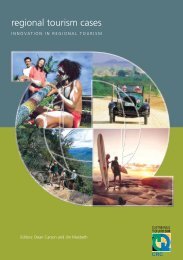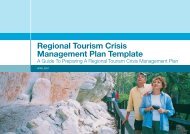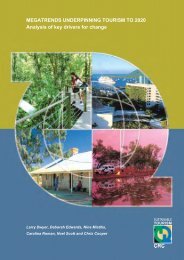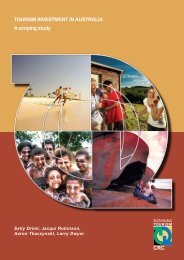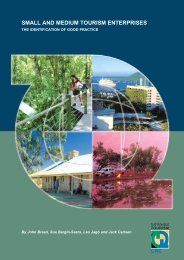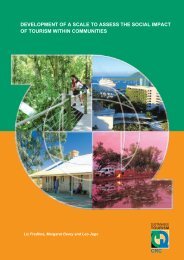Tourism Risk Management - Sustainable Tourism Online
Tourism Risk Management - Sustainable Tourism Online
Tourism Risk Management - Sustainable Tourism Online
You also want an ePaper? Increase the reach of your titles
YUMPU automatically turns print PDFs into web optimized ePapers that Google loves.
• The Government of Bangladesh has disaster management committees at the national and<br />
field levels and a Disaster <strong>Management</strong> Bureau and Department of Food and Disaster<br />
<strong>Management</strong>. Their Comprehensive Disaster <strong>Management</strong> Program (CDMP) is based upon a<br />
disaster risk management culture with programs including partnership development,<br />
community empowerment, capacity-building, research information management, and<br />
response management. CDMP seeks to ensure that disaster management is integrated within<br />
the core business of government, with strong links with development planning. Local Disaster<br />
Action Plans have been developed for 900 communities.<br />
• The Cook Islands has a National Disaster Council as the focal point for all disaster<br />
management activities with a National Disaster <strong>Management</strong> Office as the secretariat of the<br />
NDC. The Outer Islands Island Secretary and Island Council Mayor are responsible for the<br />
development of disaster management activities on their respective islands. The island system<br />
is modelled on the national system to ensure uniformity. The National Disaster Council assists<br />
them by providing guidance, policy advice and resources.<br />
Comprehensive Disaster <strong>Management</strong> Programs (CDMPs) jointly funded by the United Nations<br />
Development Program (UNDP) and the Department for International Development (DFID) have been<br />
launched in many Asian countries since November 2003. The United Nations International Strategy<br />
for Disaster Reduction (UNISDR) underpins the development of disaster management programs in<br />
Asia and the Pacific.<br />
The Asian Disaster Preparedness Centre<br />
Training, education and support are available through the Asian Disaster Preparedness Centre<br />
(ADPC) in Bangkok (http://www.adpc.net). Established in 1986 with financial assistance from the<br />
United Nations Development Program (UNDP) at the recommendation of the United Nations Disaster<br />
Relief Organization (now the Office for the Coordination of Humanitarian Affairs - OCHA), ADPC is a<br />
non-profit organization supporting the advancement of safer communities and sustainable<br />
development through the implementation of programs and projects which reduce the impact of<br />
disasters upon countries and communities in Asia and the Pacific by:<br />
• developing and enhancing sustainable institutional disaster risk management capacities,<br />
frameworks and mechanisms, and supporting the development and implementation of<br />
government policies;<br />
• facilitating the dissemination and exchange of disaster risk management expertise,<br />
experience and information; and<br />
• raising awareness and enhancing disaster risk management knowledge and skills.<br />
The Centre is staffed by professionals from many different countries and draws upon the expertise<br />
and experience of some 350 associates and a network of more than 4,300 alumni spread across 75<br />
countries.<br />
The Centre’s geographical area of interest embraces South East and East Asia, the Indian subcontinent<br />
and the Pacific. ADPC works closely with local communities, local and national<br />
governments and regional bodies to raise awareness, promote appropriate policies, establish<br />
sustainable institutional mechanisms, enhance knowledge and skills, and facilitate the exchange of<br />
experience and expertise on risk, disaster and crisis management. ADPC programs are diverse in<br />
application, address all types of hazards, and cover all aspects of the crisis and risk management<br />
spectrum from prevention and mitigation, through preparedness and response, to rehabilitation and<br />
reconstruction.<br />
48 <strong>Tourism</strong> <strong>Risk</strong> <strong>Management</strong> – An Authoritative Guide to Managing Crises in <strong>Tourism</strong>



